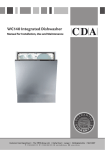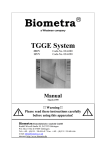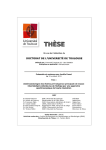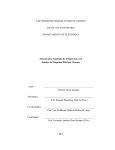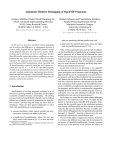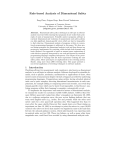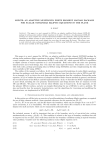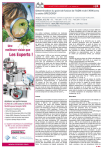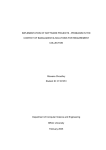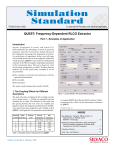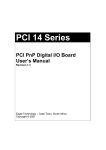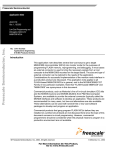Download THREE PARALLEL PROGRAMMING PARADIGMS
Transcript
THREE PARALLEL PROGRAMMING PARADIGMS: COMPARISONS ON AN ARCHETYPAL PDE COMPUTATION M. EHTESHAM HAYDER∗ , CONSTANTINOS S. IEROTHEOU† , AND DAVID E. KEYES‡ Abstract. Three paradigms for distributed-memory parallel computation that free the application programmer from the details of message passing are compared for an archetypal structured scientific computation — a nonlinear, structured-grid partial differential equation boundary value problem — using the same algorithm on the same hardware. All of the paradigms — parallel languages represented by the Portland Group’s HPF, (semi-)automated serial-to-parallel source-tosource translation represented by CAPTools from the University of Greenwich, and parallel libraries represented by Argonne’s PETSc — are found to be easy to use for this problem class, and all are reasonably effective in exploiting concurrency after a short learning curve. The level of involvement required by the application programmer under any paradigm includes specification of the data partitioning, corresponding to a geometrically simple decomposition of the domain of the PDE. Programming in SPMD style for the PETSc library requires writing only the routines that discretize the PDE and its Jacobian, managing subdomain-to-processor mappings (affine global-to-local index mappings), and interfacing to library solver routines. Programming for HPF requires a complete sequential implementation of the same algorithm as a starting point, introduction of concurrency through subdomain blocking (a task similar to the index mapping), and modest experimentation with rewriting loops to elucidate to the compiler the latent concurrency. Programming with CAPTools involves feeding the same sequential implementation to the CAPTools interactive parallelization system, and guiding the source-to-source code transformation by responding to various queries about quantities knowable only at runtime. Results representative of “the state of the practice” for a scaled sequence of structured grid problems are given on three of the most important contemporary high-performance platforms: the IBM SP, the SGI Origin 2000, and the CRAY T3E. 1. Introduction. Parallel computations advance through synergism in numerical algorithms and system software technology. Algorithmic advances permit more rapid convergence to more accurate results with the same or reduced demands on processor, memory, and communication subsystems. System software advances provide more convenient expression and greater exploitation of latent algorithmic concurrency, and take improved advantage of architecture. These advances can be appropriated by application programmers through a variety of means: parallel languages that are compiled directly, source-to-source translators that aid in the embedding of data exchange and coordination constructs into standard high-level languages, and parallel libraries that support specific parallel kernels. In this paper, we compare all three approaches as represented by “state-of-the-practice” software on three machines that can be programmed using message passing. Unfortunately, the development and tuning of a parallel numerical code from scratch remains a time-consuming task. The burden on the programmer may be reduced if the high-level programming language itself supports parallel constructs, which is the philosophy that underlies the High Performance Fortran [26] extensions to Fortran. With varying degrees of hints from programmers, the HPF approach leaves the responsibility of managing concurrency and data communication to the compiler and runtime system. The difficulty of complete and fully automatic interprocedural dependence analysis and disambiguation in a language like Fortran suggests the opportunity for an ∗ Center for Research on High Performance Software, Rice University, Houston, TX 77005, USA, [email protected], † Parallel Processing Research Group, University of Greenwich, London SE18 6PF, UK, [email protected] ‡ Computer Science Department, Old Dominion University and ICASE, Norfolk, VA 23529-0162, USA, [email protected] 1 interactive source-to-source approach to parallelization. CAPTools [16] is such an interactive authoring system for message-passing parallel code. Parallel libraries offer a somewhat higher level solution for tasks which are sufficiently common that libraries have been written for them. The philosophy underlying parallel libraries is that for high performance, some expert human programmer must become involved in the concurrency detection, process assignment, interprocess data transfer, and process-to-processor mapping — but only once for each algorithmic archetype. A library, perhaps with multiple levels of entry to allow the application programmer to employ defaults or to exert detailed control, is the embodiment of algorithmic archetypes. One such parallel library is PETSc [3], under continuous expansion at Argonne National Laboratory since 1991. PETSc provides a wide variety of parallel numerical routines for scalable applications involving the solution of partial differential and integral equations, and certain other regular data parallel applications. It uses message passing via MPI and assumes no physical data sharing or global address space. In this study we compare the three paradigms discussed above on a simple problem representative of low-order structured-grid discretizations of nonlinear elliptic PDEs — the so-called “Bratu” problem. The solution algorithm is a Newton-Krylov method with subdomain-concurrent ILU preconditioning, also known as a Newton-KrylovSchwarz (NKS) method [22]. Its basic components are typical of other algorithms for PDEs: (1) sparse matrix-vector products (together with Jacobian matrix and residual vector evaluations) based on regular multidimensional grid stencil operations, (2) sparse triangular solution recurrences, (3) global reductions, and (4) DAXPYs. Our goal is to examine the performance and scalability of these three different programming paradigms for this broadly important class of scientific computations. With relatively modest effort, we obtain similar and reasonable performance using any of the three paradigms, suggesting that all three technologies are mature for static structured problems. This study expands on [14] by bringing the CAPTools system into the comparison (an important addition, since the CAPTools approach often edges out the other two in performance) and by comparisons of the three systems on three machines, instead of just the IBM SP. The organization of this paper is as follows. Section 2 describes a model nonlinear PDE problem and its discretization and solution algorithm. Section 3 discusses the HPF, CAPTools, and PETSc implementations of the algorithm. The performance of the implementations is compared, side-by-side, in Section 4, and we conclude in Section 5. Our target audience includes both potential users of parallel systems for PDE simulation and developers of future versions of parallel languages, tools, and libraries. 2. Problem and Algorithm. Our test case is a classic nonlinear elliptic PDE, known as the Bratu problem. In this problem, generation from a nonlinear reaction term is balanced by diffusion. The model problem is given by (2.1) −∇2 u − λeu = 0, with u = 0 at the boundary, where λ is a constant known as the Frank-Kamenetskii parameter in the combustion context. The Bratu problem is a part of the MINPACK2 test problem collection [2] and its solution is implemented in a variety of ways in the distribution set of demo drivers for the PETSc library, to illustrate different features of PETSc for nonlinear problems. There are two possible steady-state solutions to this problem for certain values of λ. One solution is close to u = 0 and is easy to 2 obtain. A close starting point is needed to converge to the other solution. For our model case, we consider a square domain of unit length and λ = 6. We use a standard central difference scheme on a uniform grid (shown in Figure 2.1) to discretize (2.1) as uij , i, j = 0, n = 0, fij (u) ≡ 4ui,j − ui−1,j − ui+1,j − ui,j−1 − ui,j+1 − h2 λeui,j , otherwise where fij is a function of the vector of discrete unknowns uij , defined at each interior and boundary grid point: ui,j ≈ u(xi , yj ); xi ≡ ih, i = 0, 1, . . . , n; yj ≡ jh, j = 0, 1, . . . n, h ≡ n1 . The discretization leads to a nonlinear algebraic problem of dimension (n + 1)2 , with a sparse Jacobian matrix of condition number O(n2 ), asymptotically in n, for fixed λ. The typical number of nonzeros per row of the Jacobian is five, with just one in rows corresponding to boundary points of the physical domain. The algorithmic discussion in the balance of this section is sufficient to understand the main computation and communication costs in solving nonlinear elliptic boundary value problems like (2.1), but we defer full parallel complexity studies, including a discussion of optimal parallel granularities, partitioning strategies, and running times to the literature, e.g. [12, 24]. In this study, most of the computations were done using one-dimensional domain decomposition (shown in Figure 2.1). We also present some results for two-dimensional blocking. Outer Iteration: Newton. We solve f (u) = 0 by an inexact Newton-iterative method with a cubic backtracking line search [10]. We use the term “inexact Newton method” to denote any nonlinear iterative method approaching the solution u through a sequence of iterates u` = u`−1 + α · δu` , beginning with an initial iterate u0 , where α is determined by some globalization strategy, and δu` approximately satisfies the true Newton correction linear system (2.2) f 0 (u`−1 ) δu = −f (u`−1 ), in the sense that the linear residual norm ||f 0 (u`−1 ) δu` +f (u`−1 )|| is sufficiently small. Typically the RHS of the linear Newton correction equation, which is the negative of the nonlinear residual vector, f (u`−1 ), is evaluated to full precision. The inexactness arises from an incomplete convergence employing the true Jacobian matrix, f 0 (u), freshly evaluated at u`−1 , or from the employment of an inexact or a “lagged” Jacobian. An exact Newton method is rarely optimal in terms of memory and CPU resources for large-scale problems, such as finely resolved multidimensional PDE simulations. The pioneering work in showing that properly tuned inexact Newton methods can save enormous amounts of work over a sequence of Newton iterations, while still converging asymptotically quadratically, is [9]. We terminate the nonlinear iterations at the ` for which the norm of the nonlinear residual first falls below a threshold defined relative to the initial residual: ||f (u` )||/||f (u0 )|| < τrel . Our τrel in Section 4 is a loose 0.005, to keep total running times modest in the unpreconditioned cases considered below, since the asymptotic convergence behavior of the method has been well studied elsewhere. Inner Iteration: Krylov. A Newton-Krylov method uses a Krylov method to solve (2.2) for δu` . From a computational point of view, one of the most important characteristics of a Krylov method for the linear system Ax = b is that information about the matrix A needs to be accessed only in the form of matrix-vector products in a relatively small number of carefully chosen directions. When the matrix A 3 represents the Jacobian of a discretized system of PDEs, each of these matrix-vector products is similar in computational and communication cost to a stencil update phase of an explicit method applied to the same set of discrete conservation equations. Periodic nearest-neighbor communication is required to “ghost” the values present in the boundary stencils of one processor but maintained and updated by a neighboring processor. We use the restarted generalized minimum residual (GMRES) [30] method for the iterative solution of the linearized equation. (Though the linearized operator is self-adjoint, we do not exploit symmetry in the iterative solver, since symmetry is too special for general applications and since our implementation of the discrete boundary conditions does Pmnot preserve symmetry.) GMRES constructs an approximation solution x = i=1 ci vi as a linear combination of an orthogonal basis vi of a Krylov subspace, K = {r0 , Ar0 , A2 r0 , . . .}, built from an initial residual vector, r0 = b − Ax0 , by matrix-vector products and a Gram-Schmidt orthogonalization process. This Gram-Schmidt process requires periodic global reduction operations to accumulate the locally summed portions of the inner products. We employ the conventional modified Gram-Schmidt process that reduces each inner product in sequence as opposed to the more communication-efficient version that simultaneously reduces a batch of inner products. However, in well preconditioned time-evolution problems and on large numbers of processors, we often prefer the batched version. Restarted GMRES of dimension m finds the optimal solution of Ax = b in a least squares sense within the current Krylov space of dimension up to m and repeats the process with a new subspace built from the residual of the optimal solution in the previous subspace if the resulting linear residual does not satisfy the convergence criterion. The residual norm is monitored at each intermediate stage as a by-product of advancing the iteration. GMRES is well-suited for inexact Newton methods, since its convergence can be terminated at any point, with an overall cost that is monotonically and relatively smoothly related to convergence progress. By restarting GMRES at relatively short intervals we can keep its memory requirements bounded. However, a global convergence theory exists only for the nonrestarted version. For problems with highly indefinite matrices, m may need to approach the full matrix dimension, but this does not occur for practically desired λ in (2.1). We define the GMRES iteration for δu` at each outer iteration ` with an inner iteration index, k = 0, 1, . . ., such that δu`,0 ≡ 0 and δu`,∞ ≡ δu` . We terminate GMRES at the k for which the norm of the linear residual first falls below a threshold defined relative to the initial: ||f (u`−1 ) + f 0 (u`−1 ) δu`,k ||/||f (u`−1 )|| < σrel , or at which it falls below an absolute threshold: ||f (u`−1 ) + f 0 (u`−1 ) δu` || < σabs . In the experiments reported below, σrel is 0.5 and σabs is 0.005. (Ordinarily, in an application for which it is good preconditioning is easily afforded, such as this one, we would employ a tighter σrel . However, we wish to compare preconditioned and unpreconditioned cases while keeping the comparison as uncomplicated by parameter differences as possible.) A relative mix of matrix-vector multiplies, function evaluations, inner products, and DAXPYs similar to those of more complex applications is achieved with these settings. The single task that is performed more frequently relative to the rest than might occur in practice is that of Jacobian matrix evaluation, which we carry out on every Newton step. Inner Iteration Preconditioning: Schwarz. A Newton-Krylov-Schwarz method combines a Newton-Krylov (NK) method with a Krylov-Schwarz (KS) method. If the Jacobian A is ill-conditioned, the Krylov method will require an unacceptably 4 large number of iterations. The system can be transformed into the equivalent form B −1 Ax = B −1 b through the action of a preconditioner, B, whose inverse action approximates that of A, but at smaller cost. It is in the choice of preconditioning where the battle for low computational cost and scalable parallelism is usually won or lost. In KS methods, the preconditioning is introduced on a subdomain-by-subdomain basis through conveniently concurrently computable approximations to local Jacobians. Such Schwarz-type preconditioning provides good data locality for parallel implementations over a range of parallel granularities, allowing significant architectural adaptability [13]. In our tests, the preconditioning is applied on the right-hand side; that is, we solve M y = b, where M = AB −1 , and recover x = B −1 y with a final application of the preconditioner to the y that represents the converged solution. Two-level Additive Schwarz preconditioning [11] with modest overlap between the subdomains and a coarse grid is “optimal” for this problem, for sufficiently small λ. (We use “optimal” in the sense that convergence rate is asymptotically independent of the fineness of the grid and the granularity of the partitioning into subdomains. For more formally stated conditions on the overlap and the coarse grid required for this, see [31].) However, for conformity with common parallel practice and simplicity of coding, we employ a “poor man’s” Additive Schwarz, namely single-level zero-overlap subdomain-block Jacobi. We further approximate the subdomain-block Jacobi by performing just a single iteration of zero-fill incomplete lower/upper factorization (ILU) on each subdomain during each preconditioner phase. These latter two simplifications (zero overlap and zero fill) save communication, computation, and memory relative to preconditioners with modest overlap and modest fill that possess provably superior convergence rates. Domain-based parallelism is recognized by architects and algorithmicists as the form of data parallelism that most effectively exploits contemporary multi-level memory hierarchy microprocessors [8, 25, 33]. Schwarztype domain decomposition methods have been extensively developed for finite difference/element/volume PDE discretizations over the past decade, as reported in the annual proceedings of the international conferences on domain decomposition methods (see, e.g., [5] and the references therein). The trade-off between cost per iteration and number of iterations is variously resolved in the parallel implicit PDE literature, but our choices are rather common and not far from optimal, in practice. Algorithmic Behavior. Contours of the initial iterate (u0 ) and final solution (u ) for our test case are shown in Figure 2.2. Figure 2.3 contains a convergence history for Schwarz-ILU preconditioning on a 512 × 512 grid and for no preconditioning on a quarter-size 256 × 256 grid. The convergence plot depicts in a single graph the outer Newton history and the sequence of inner GMRES histories, as a function of cumulative GMRES iterations; thus, it plots incremental progress against a computational work unit that approximately corresponds to the conventional multigrid work unit of a complete set of stencil operations on the grid. The plateaus in the residual norm plots correspond to successive values of ||f (u` )||, l = 0, 1, . . .. (There are five such intermediate plateaus in the preconditioned case, separating the six Newton correction cycles.) The typically concave-down arcs connecting the plateaus correspond to ||f (u`−1 ) + f 0 (u`−1 ) δu`,k ||, k = 0, 1, . . . for each `. By Taylor’s theorem f (u` ) ≈ f (u`−1 ) + f 0 (u`−1 ) δu` + O((δu` )2 ), so for truncated inner iterations, for which δu` is small, the Taylor estimate for the nonlinear residual norm at the end of every Newton step is an excellent approximation for the true nonlinear residual norm at the beginning of the next Newton step. We do not actually evaluate the true nonlinear residual norm more frequently than once at the end of each cycle of ∞ 5 Domain 1 Domain 2 Fig. 2.1. Computational domain interface, showing on-processor (open arrowhead) and off-processor (filled arrowhead) data dependencies for the 5-point star stencil Y Y 1.0 2 3 4 6 7 0.8 A 6 2 3 4 B 7 65 9 7 C B 0.6 C 0.4 8 A D 9 A 3 2 D E 8 C 5 4 0.2 A 7 7 65 9 8 7 23 0.0 4 B 6 2 3 6 F E D 0.6 0.557143 0.514286 C B A 9 8 7 6 5 4 3 2 1 0.471429 0.428571 0.385714 0.342857 0.3 0.257143 0.214286 0.171429 0.128571 0.0857143 0.0428571 0 4 Level u 6 8 9 0.8 1 2 3 7 2 B A 3 4 6 78 0.6 D E C 5 3 4 1 2 A C 5 9 2 8 D B C 1 0.0 1 3 2 A 9 8 23 6 B E B 1 0.2 7 D 9 0.4 5 4 5 4 5 Level u 8 9 5 4 1 1.0 3 2 5 8 7 5 6 4 3 F E D C B A 9 8 0.6 0.557143 0.514286 0.471429 0.428571 0.385714 0.342857 0.3 7 6 5 4 3 2 1 0.257143 0.214286 0.171429 0.128571 0.0857143 0.0428571 0 2 1 1 X X 0.0 0.5 1.0 1.5 0.0 0.5 1.0 1.5 Fig. 2.2. Contour plots of initial condition and converged solution GMRES iterations (that is, on the plateaus); the intermediate arcs are Taylor-based interpolations. 3. Parallel Implementations. 3.1. HPF Implementation. High Performance Fortran (HPF) is a set of extensions to Fortran, designed to facilitate efficient data parallel programming on a wide range of parallel architectures [15]. The basic approach of HPF is to provide directives that allow the programmer to specify the distribution of data across processors, which in turn helps the compiler effectively exploit the parallelism. Using these directives, the user provides high-level “hints” about data locality, while the compiler generates the actual low-level parallel code for communication and scheduling that is appropriate for the target architecture. The HPF programming paradigm provides a 6 0 L2 norm of the residual 10 ILU preconditioning No preconditioning −1 10 −2 10 −3 10 1 10 100 Number of GMRES steps 1000 Fig. 2.3. Convergence histories of illustrative unpreconditioned (256 × 256) and global ILU-preconditioned (512 × 512) cases global name space and a single thread of control allowing the code to remain essentially sequential with no explicit tasking or communication statements. The goal is to allow architecture-specific compilers to transform this high-level specification into efficient explicitly parallel code for a wide variety of architectures. HPF provides an extensive set of directives to specify the mapping of array elements to memory regions referred to as “abstract processors.” Arrays are first aligned relative to each other, and then the aligned group of arrays is distributed onto a rectilinear arrangement of abstract processors. The distribution directives allow each dimension of an array to be independently distributed. The simplest forms of distribution are block and cyclic; the former breaks the elements of a dimension of the array into contiguous blocks that are distributed across the target set of abstract processors, while the latter distributes the elements cyclically across the abstract processors. Data parallelism in the code can be expressed using the Fortran array statements. HPF provides the independent directive, which can be used to assert that the iterations of a loop do not have any loop-carried dependencies and thus can be executed in parallel. HPF is well suited for data parallel programming. However, in order to accommodate other programming paradigms, HPF provides extrinsic procedures. These define an explicit interface and allow codes expressed using a different language, e.g., C, or a different paradigm, such as an explicit message-passing code, to be called from an HPF program. The first version of HPF, version 1.0, was released in 1994 and used Fortran 90 as its base language. HPF 2.0, released in January 1997, added new features to the language while modifying and deleting others. Some of the HPF 1 features, e.g., the forall statement and construct, were dropped because they have been incorporated into Fortran 95. The current compilers for HPF, including the PGI compiler, used 7 for generating the performance figures in this paper, support the features in HPF 1 only and use Fortran 90 as the base language. We have provided only a brief description of some of the features of HPF. A full description can be found in [15], while a discussion of how to use these features in various applications can be found in [7, 28, 29]. Conversion of the Code to HPF. The original code for the Bratu problem was a Fortran 77 implementation of the NKS method of Section 2, written by one of the authors, which pre-dated the PETSc NKS implementation. In this subsection we describe the changes made to the Fortran 77 code to port it to HPF, and the reasons for the changes. Fortran’s sequence and storage association models are natural concepts only on machines with linearly addressed memory and cause inefficiencies when the underlying memory is physically distributed. Since HPF targets architectures with distributed memories, it does not support storage and sequence association for data objects that have been explicitly mapped. The original code relied on Fortran’s model of sequence association to redimension arrays across procedures in order to allow the problem size, and thus the size of the data arrays, to be determined at runtime. The code had to be rewritten so that the sizes of the arrays are hardwired throughout and there is no redimensioning of arrays across procedure boundaries. The code could have been converted to use Fortran 90 allocatable arrays; however, we chose to hardwire the sizes of the arrays. This implied that the code needed to be recompiled whenever the problem size was changed. (This is, of course, no significant sacrifice of programmer convenience or code generality when accomplished through parameter and include statements and makefiles. It does, however, cost the time of recompilation.) We mention a few other low-level details of the conversion because they address issues that may be more widely applicable in ports to HPF. During the process of conversion, some of the simple do loops were converted into array statements; however, most of the loops were left untouched and were automatically parallelized by PGI’s HPF compiler. That is, we did not need to use either the forall construct or the independent directive for these loops — they were simple enough for the compiler to analyze and parallelize automatically. Along with this, two BLAS library routines used in the original code, ddot and dnrm2, were explicitly coded since the BLAS libraries have not been converted for use with HPF codes. The original solver was written for a system of equations with multiple unknowns at each grid point. To specialize for a scalar equation we deleted the corresponding inner loops and the corresponding indices from the field and coefficient arrays. We thereby converted four-dimensional Jacobian arrays (in which was expressed each nontrivial dependence of each residual equation on each unknown at each point in two-dimensional space) into two-dimensional arrays (since both number of residual equation and unknown is one, we needed only two-dimensional arrays to store values at each grid point). This, in turn, reduced some dense point-block linear algebra subroutines to scalar operations, which we inlined. We also rewrote the matrix multiplication routine to utilize a single do loop instead of nine small loops, each of which took care of a different interior or side boundary or corner boundary stencil configuration. Some trivial operations are thereby added near boundaries, but checking proximity of the boundary and setting up multiple do loops are avoided. The original nine loops caused the HPF compiler to generate multiple communication statements. Rewriting the code to use a single do loop allowed the compiler to generate the optimal number of communication statements even 8 though a few extra values had to be communicated. The sequential ILU routine in the original code was converted to subdomain-block ILU to conform to the simplest preconditioning option in the PETSc library. This was done by strip-mining the loops in the x- and y-directions to run over the blocks, with a sequential ILU within each block. Even though there were no dependencies across the block loops, the HPF compiler could not optimize the code and generated a locality check within the internal loop. This caused unnecessary overhead in the generated code. We avoided the overhead by creating a subroutine for the code within the block loops and declaring it to be extrinsic. Since the HPF compiler ensures that a copy of an extrinsic routine is called on each processor, no extraneous communication or locality checks now occur while the block sequential ILU code is executed on each processor. The HPF distribution directives are used to distribute the arrays by block. For example, when experimenting with a one-dimensional distribution, a typical array is mapped as follows: real, dimension (nxi,nyi) :: U !HPF$ distribute (*, block) :: U ... do i = 1, nxi do j = 1, nyi U(i,j) = ... end do end do The above distribute directive maps the second dimension of the array U by block, i.e., the nyi columns of the array U are block-distributed across the underlying processors. As shown by the do loops above, the computation in an HPF code is expressed using global indices independent of the distribution of the arrays. To change the mapping of the array U to a two-dimensional distribution, the distribution directive needs to be modified as follows, so as to map a contiguous sub-block of the array onto each processor in a two-dimensional array of processors: real, dimension (nxi,nyi) :: U !HPF$ distribute (block, block) :: U ... do i = 1, nxi do j = 1, nyi U(i,j) = ... end do end do The code expressing the computation remains the same; only the distribute directive itself is changed. It is the compiler’s responsibility to generate the correct parallel code along with the necessary communication in each case. Most of the revisions discussed above do nothing more than convert Fortran code written for sequential execution into an equivalent sequential form that is easier for the HPF compiler to analyze, thus allowing it to generate more efficient parallel code. The only two exceptions are: (a) the mapping directives, which are comments (see code example above) and are thus ignored by a Fortran 90 compiler, and (b) the declaration of two routines, the ILU factorization and forward/backsolve routines, to be extrinsic. Regularity in our problem helped us in parallelizing the code with these extrinsic calls and a small number of HPF directives. The HPF mapping directives, 9 USER Domain input parameters/ decomposition code FORTRAN SEQUENTIAL CODE Browser/Editor strategy Browser/Editor Mask inspection and editing Browser/Editor Communication tuning Browser/Editor Loop optimisation e.g. routine copy etc Transformations Code generation Interprocedural dependency Data partitioning analysis Execution Communication control mask generation and generation optimisation Setup for multi-dimensional FORTRAN PARALLEL CODE Knowledge about partitioning APPLICATION DATABASE User knowledge Parse tree Control flow Execution control masks Dependencies(scalar,array,control) Communications Partition definition CAPLib CAPTools Fig. 3.1. Overview of CAPTools themselves, constitute only about 5% of the line count of the total code. The compilation command, showing the autoparallelization switch and the optimization level used in the performance-oriented executions, is: pghpf -Mpreprocess -Mautopar -O3 -o bratu bratu.hpf 3.2. CAPTools Implementation. The Computer Aided Parallelisation Tools (CAPTools) [16] were initially developed to assist in the process of parallelizing computational mechanics (CM) codes. A key characteristic of CAPTools addresses the issue that the code parallelization process could not, in general, be fully automated. Therefore, the interaction between the code parallelizer and CAPTools is crucial during the process of parallelizing codes. An overview of the structure of CAPTools is shown in Figure 3.1. The main components of the tools comprise: • A detailed control and dependence analysis of the source code, including the acquisition and embedding of user supplied knowledge. • User definition of the parallelization strategy. • Automatic adaptation of the source code to an equivalent parallel implementation. • Automatic migration, merger and generation of all required communications. • Code optimization including loop interchange, loop splitting, and communication /calculation overlap. The creation of an accurate dependence graph is essential in all stages of the parallelization process from parallelism detection to communication placement. As a result, considerable effort is made in the analysis to prove the non-existence of dependencies. This enables the calculation of a significantly higher quality dependence 10 graph for the parallelization process. CAPTools does not carry out any inlining of code because it is essential to retain the original form when generating parallel code to allow continued user recognition. Instead, it performs an interprocedural analysis [17]. The power of the interprocedural analysis derives from both scalar and array variables being accurately traced through routine boundaries. Another key factor in improving the quality of the dependence analysis is the sophisticated, high level interaction with the code parallelizer. The parallel code generation process implemented within CAPTools follows closely the successful techniques developed and exploited in numerous manual parallelizations. These features enable generation of high quality parallel code. The current programming model is based on the single program multiple data (SPMD) concept where each processor executes the same code but operates only on its allocated subset of the original data set. Data is communicated between processors via message-passing routines and although the distributed memory system is used as the target system, the use of OpenMP directives makes the generation of high quality parallel code equally applicable to shared memory systems. A key component of any knowledge from the user is the specification of the parallelization strategy. The decomposition strategy for structured mesh codes is relatively simple and involves partitioning the mesh into blocks. The user can also specify a cyclic, hybrid block-cyclic or domain decomposition-based unstructured mesh partition. In the latter case, the Jostle tool [32] is used to create the sub-partitions based upon the mesh topology. In general, the user defines the data partitioning by specifying a routine, an array variable within the routine and also an index or subset of the array. From this initial definition CAPTools calculates any side effects. The partitioning algorithm systematically checks all related array references with the partitioned information and where possible this partition information is inherited by the related array. The algorithm proceeds interprocedurally so that information can propagate from one routine to its callers and called routines. In addition, dimension mapping between routines (e.g., where a 1D array becomes a 2D array in a called routine) is correctly handled, avoiding the need for any code re-authoring. Often, the selection of a single array is sufficient to generate a comprehensive data partition. For block partitions of structured mesh codes, CAPTools generates symbolic variables that define low and high limits prefixed as CAP L and CAP H respectively, where private copies of these variables are held on every processor to determine the subset of the data set for a particular array owned by that processor. The generation of parallel code from an analyzed sequential code that has been appropriately partitioned is obtained by the following three stages within CAPTools (the reader is referred to [18] for a more detailed description of the code generation process): • The computation of execution control masks for every statement in the code (to ensure that appropriate statements are activated only by the processor that owns the data being assigned by this statement or transitively related statements). Execution control masks that cannot be transformed into loop limit alterations are frequently generated as block IF masks, where a number of masks are merged into a single conditional statement. • The identification, migration, and merger of the required communication statements. First, the communication requests are calculated indicating the potential need for data communication. Second, these requests are moved “upwards” using the control flow graph in the code being parallelized (including interprocedural migration) until they are prevented from further mi11 gration, usually by the assignment of the data item being communicated. Third, communication requests that have migrated to the same point in the code are merged by comparing the data space they cover. Finally, the communication statements are generated from the remaining requests and form a part of the parallel code. • The generation of parallel source code. The communication calls that are inserted into the generated parallel code use the CAPTools communications library (CAPLib [27]). The CAPLib library calls map onto machine specific functions such as CRAY-shmem, or standard libraries such as MPI, PVM, etc. For example, the cap send and cap receive communication statements are paired for one-way message passing, the cap exchange is used for two-way paired exchanges of data, and the cap commutative routine is used for global operations such as norms and inner products. The CAPTools parallelization of the Bratu code with an ILU preconditioner using a 2D block partition. The Bratu code requires no re-authoring or modification of the original sequential code to create a parallel version using CAPTools. The dependence analysis for the Bratu code is straightforward since all array sizes and problem definition parameters are all hand coded into the sequential source code. This also means that there is little or no need for the user to provide additional information about the code to assist in the dependence analysis. The dependence analysis reveals that there are 66 potentially parallel loops out of the 79 loops in the code. The sequential loops of greatest interest are identified as those in the ILU-preconditioner routines, as well as the routine that executes the preconditioned generalized minimal residual method (pcgmr). The 2D block partition is prescribed using two passes of the CAPTools process, i.e., data partitioning, execution control mask identification, and communication generation [20]. In the first pass, a 1D block partition is defined by the user by selecting the array of Krylov vectors within pcgmr and index 2 (i.e., the y-dimension). Following the computation of the execution control masks, the communication calls are generated. For the Bratu code, these can be categorized into three types: • Exchanges of overlap or halo information, e.g., in the evaluation of nodal residuals using data owned by a neighboring processor. • Global reduction operations, e.g., the computation of an L2-norm and a dot product in routines dnrm2 and ddot, respectively. • Pipeline communications, e.g., in the routine ilupre the computation for the preconditioned output vector is pipelined since it has a recurrence in the partitioned y-dimension. After the generation of communication calls, the user selects an orthogonal dimension in the partitioner window to produce a 2D block partition. The partition in the second pass is defined by selecting the Krylov vector array and index 1 (i.e., the x-dimension). This is again followed by execution control mask computation and communication generation. The communication is of a similar nature to that generated in the y-dimension. The complete interactive parallelization of the Bratu code with a 2D block partitioning starting from the original serial code, takes less than ten minutes using a DEC Alpha workstation. The CAPTools-generated parallel Bratu code with an ILU preconditioner. The first call made in the parallel version of the code is the call to cap init to create and/or initialize tasks for each processor, as required by the underlying 12 message-passing interface. Immediately after the problem size is defined, two calls to cap setupdpart are made to define the low and high assignment ranges for each processor, based on the problem size and the processor topology as defined at runtime. Due to the explicit nature of the code, most of the execution control masks are transformed from individual statements within a loop to the loop limits, replacing the original loop limits: do j2=max(1,cap_lvv),min(nyi,cap_hvv) do i2=max(1,cap2_lvv),min(nxi,cap2_hvv) VV(i2,j2) = -W1(i2,j2) + RHS(i2,j2) enddo enddo The variables cap lvv, cap hvv, cap2 lvv and cap2 hvv define the partition range on the executing processor. The use of the intrinsic functions max and min ensures that the original loop limits are respected. In the generated code, the identification and placement of communication calls are local to each routine. This is somewhat sympathetic to the current HPF/F90 compiler technology, but is perceived as a basic operation within CAPTools since it does not make use of the interprocedural capability. The parallel Bratu code with an ILU preconditioner (generated by CAPTools) is similar in appearance to the original sequential code, therefore, it can be maintained and developed further by the code authors. Indeed, this point is highlighted by enabling the code author to transform the ILU preconditioner to a block Jacobi preconditioner by modifying the CAPToolsgenerated code. Such an algorithmic change from global ILU to block Jacobi ILU is identical to the change performed on the HPF version (noted in §3.1) by exploiting its extrinsic feature and provides both the CAPTools and HPF versions with one of the parallel preconditioners provided as part of the PETSc library. Modification of the global ILU preconditioner to create a block Jacobi ILU preconditioner. The CAPTools-generated code is correct; however, the original ILU preconditioner contains global recurrences with insufficient concurrency for parallel execution. Two alterations to the ILU preconditioner algorithm can be made to transform the generated parallel code so that it employs a block Jacobi preconditioner. These fundamental changes to the ILU preconditioner algorithm break the recurrence and remove the dependence on data residing on a different neighboring processor: (1) The removal of communication calls within the iluini and ilupre routines to remove the dependence on data belonging to neighboring processors. For example, in routine ilupre, the pipeline communications are simply commented out. c call cap_receive(MX(cap2_lvv,cap_lvv-1), c & cap2_hvv-cap2_lvv+1,2,cap_left) c call cap_breceive(MX(cap2_lvv-1,cap_lvv),1,nxi, c & cap_hvv-cap_lvv+1,2,cap_up) do 15 j=max(ny1,cap_lvv),min(ny2,cap_hvv) do 1 i=max(nx1,cap2_lvv),min(nx2,cap2_hvv) TEMP1=0.0 TEMP2=0.0 TEMP3=0.0 TEMP4=0.0 13 if(i.gt.nx1) then TEMP1=QW(i,j)*MX(i-1,j) endif if(j.gt.ny1) then TEMP2=QS(i,j)*MX(i,j-1) endif MX(i,j)=AX(i,j)-TEMP1-TEMP2-TEMP3-TEMP4 1 continue 15 continue c call cap_bsend(MX(cap2_hvv,cap_lvv),1,nxi, c & cap_hvv-cap_lvv+1,2,cap_down) c call cap_send(MX(cap2_lvv,cap_hvv)),cap2_hvv-cap2_lvv+1, c & 2,cap_right) (2) The alteration of the execution control masks in the routine ILUPRE to ensure that only data within the assignment ranges are assigned and used. Together with (1) this has the effect of fundamentally altering the algorithm to use a block Jacobi ILU preconditioner instead of one based on a global ILU factorization. if(i.gt.max(nx1,cap2_lvv)) then TEMP1=QW(i,j)*MX(i-1,j) endif if(j.gt.max(ny1,cap_lvv)) then TEMP2=QS(i,j)*MX(i,j-1) endif Compilation and execution of the CAPTools-generated code is straightforward and requires the installation of CAPLib and the capmake and caprun scripts. There are versions of CAPLib available for all the major parallel systems. The following generic command is used to compile the Bratu 2D code (with Fortran compiler optimizations): capmake -O bratu_2D For example, on the IBM SP the -O option is set to -O3 within the capmake script. Finally, the command to execute the 2D parallel Bratu code is: caprun -top grid2x2 bratu_2D where the -top option defines the processor topology that the 2D partitioned parallel code will be mapped onto. 3.3. PETSc Implementation. Our library implementation employs the “Portable, Extensible Toolkit for Scientific Computing” (PETSc) [3, 4], a freely available software package that attempts to handle through a uniform interface, in a highly efficient way, the low-level details of the distributed memory hierarchy. Examples of such details include striking the right balance between buffering messages and minimizing buffer copies, overlapping communication and computation, organizing node code for strong cache locality, allocating memory in context-sized chunks (rather than too much initially or too little too frequently), and separating tasks into one-time and every-time subtasks using the inspector/executor paradigm. The benefits to be gained from these and from other numerically neutral but architecturally sensitive techniques are so significant that it is efficient in both the programmer-time and execution-time senses to express them in general purpose code. PETSc is a large and versatile package integrating distributed vectors, distributed matrices in several sparse storage formats, Krylov subspace methods, preconditioners, and Newton-like nonlinear methods with built-in trust region or line search strategies 14 Main Routine Nonlinear Solver (SNES) Matrix Linear Solver (SLES) PC Application Initialization Vector PETSc KSP DA Function Evaluation Jacobian Evaluation PostProcessing Fig. 3.2. Schematic of call graph for PETSc on a nonlinear boundary value problem and continuation for robustness. It has been designed to provide the numerical infrastructure for application codes involving the implicit numerical solution of PDEs, and it sits atop MPI for portability to most parallel machines. The PETSc library is written in C, but may be accessed from application codes written in C, Fortran, and C++. PETSc version 2, first released in June 1995, has been downloaded over a thousand times by users around the world. It is believed that there are many dozens of groups actively employing some subset of the PETSc library. Besides standard sparse methods and data structures for Ax = b, PETSc includes algorithmic features like matrix-free Krylov methods, blocked forms of parallel preconditioners, and various types of time-step control. Data structure-neutral libraries containing Newton and/or Krylov solvers must give control back to application code repeatedly during the solution process for evaluation of residuals, and Jacobians (or for evaluation of the action of the Jacobian on a given Krylov vector). There are two main modes of implementation: “call back,” wherein the solver actually returns, awaits application code action, and expects to be reinvoked at a specific control point; and “call through,” wherein the solver invokes application routines, which access requisite state data via COMMON blocks in conventional Fortran codes or via data structures encapsulated by context variables. PETSc programming is in the “call through” context variable style. Figure 3.2 (reproduced from [13]), depicts the call graph of a typical nonlinear application. Our PETSc implementation of the method of Section 2 for the Bratu problem is petsc/src/snes/examples/tutorial/ex5f.F from the public distribution of PETSc 2.0.22 at http://www.mcs.anl.gov/petsc/. The figure shows (in white) the five subroutines that must be written to harness PETSc via the Simplified Nonlinear Equations Solver (SNES) interface: a driver (performing I/O, allocating work arrays, and calling PETSc); a solution initializer (setting up a subdomain-local portion of u0 ); a function evaluator (receiving a subdomain-local portion of u` and returning the corresponding part of f (u` )); a Jacobian evaluator (receiving a subdomain-local 15 portion of u` and returning the corresponding part of f 0 (u` )); and a post-processor (for extraction of relevant output from the distributed solution). All of the logic of the NKS algorithm is contained within PETSc, including all communication. The PETSc executable for an NKS-based application supports a combinatorially vast number of algorithmic options, reflecting the adaptive tuning of NKS algorithms generally, but each option is defaulted so that a user may invoke the solver with little knowledge initially, study a profile of the execution, and progressively tune the solver. The options may be specified procedurally, i.e., by setting parameters within the application driver code, through a .petscrc configuration file, or at the command line. The command line may also be used to override user-specified defaults indicated procedurally, so that recompilation for solver-related adaptation is rarely necessary. (For instance, it is even possible to change matrix storage type from point- to blockoriented at the command line.) A typical run was executed with the command: mpirun -np 4 ex5f -mx 512 -my 512 -Nx 1 -Ny 4 -snes_rtol 0.005 -ksp_rtol 0.5 -ksp_atol 0.005 -ksp_right_pc -ksp_max_it 60 -ksp_gmres_restart 60 -pc_type bjacobi -pc_ilu_inplace -mat_no_unroll This example invokes (default) ILU(0) preconditioning within a subdomain-block Jacobi preconditioner, for four strip domains oriented with their long axes along the x direction. For a precise interpretation of the options, and a catalog of hundreds of other runtime options, see the PETSc release documentation. Further switches were used to control graphical display of the solution and output file logging of the convergence history and performance profiling, the printing of which was suppressed during timing runs. The PETSc libraries were built with the option BOPT=O. On the SP (PETSC ARCH=rs6000), this invokes the -O3 -qarch=pwr2 switches of the the xlc and xlf compilers. The architecture switches for the Origin and the T3E are PETSC ARCH=IRIX64 and PETSC ARCH=alpha, respectively. Each platform’s own native MPI was employed as the communication library. 4. Performance Comparisons. To evaluate the effectiveness of language and library paradigms, we compare the demonstration version of the Bratu problem in the PETSc source-code distribution with algorithmically equivalent versions of this numerical model and solver converted to message-passing parallelism via CAPTools and HPF. All performance data reported in this study are measured on unclassified machines in major shared resource centers operated by the department of defense. To attempt to eliminate “cold start” memory allocation and I/O effects, for each timed observation, we make two passes over the entire code (by wrapping a simple do loop around the entire solver) and report the second result. To attempt to eliminate network congestion effects, we run in dedicated mode (by enforcing that no other users are simultaneously running on the machine). To spot additional “random” effects, we measure each timing four times and use the average of the four values. We also check for outliers, which our precautions ultimately render extremely rare, and discard them. Cases without Preconditioning. We first consider computations without preconditioning, as shown in Figures 4.1 and 4.2 on a 256×256 grid using one-dimensional partitioning. This is a relatively small problem and we study scalability on up to 16 processors. In general, execution times and scalability of all three programming paradigms are comparable with one exception. CAPTools offers the best scaling on the SP and T3E, while on the Origin PETSc scales best. On 16 processors of the SP, 16 Execution time on SP2 Execution time on O2K HPF CAP PETSc 10 Execution time on T3E HPF CAP PETSc HPF CAP PETSc 1 1 Time 10 Time Time 10 1 10 1 1 10 NP 1 10 NP NP Fig. 4.1. Execution time on 256 × 256 grid unpreconditioned case Speed up on SP2 Speed up on O2K 16 Speed up on T3E 16 HPF CAPTools PETSc Ideal HPF CAPTools PETSc Ideal 6 1 Speed up 6 1 6 11 NP 16 HPF CAPTools PETSc Ideal 11 Speed up 11 Speed up 11 16 1 6 1 6 11 16 1 1 6 NP 11 16 NP Fig. 4.2. Speed-up for 256 × 256 grid unpreconditioned case CAPTools takes the least amount of time. Execution times for PETSc and HPF are about 40% and 50% higher, respectively. Speed-up (i.e., ratio of the execution time on a single processor to that on multiple processors) on 16 processors varies between 9 (CAPTools) and 7 (HPF). On the Origin HPF does not scale beyond 8 processors, evidently burdened by too much overhead or artifactual communication for a small grid. On 8 processors PETSc takes the least amount of time and CAPTools is about 14% slower, while the execution time for HPF is about twice that of PETSc. Computation with PETSc shows superlinear scaling, which is often an indication of greater cache reuse, as the smaller local working sets of fixed-size problems eventually drop into cache. Superlinear scaling is not present for HPF and CAPTools. On 8 processors, the speed-up of CAPTools and HPF are only about 6.5 and 3, respectively. All three programming paradigms scale better on the T3E. On 16 processors, the speed-up of the CAPTools-generated code is greater than 15, while those of HPF and PETSc are about 11.5. Cases with Preconditioning. We next examine subdomain-block Jacobi ILU preconditioning, a communicationless form of Additive Schwarz. For such preconditioners, there are slight changes in the convergence rate as number of subdomain increases. All simulations 1¡in this study are continued until they meet the same convergence criteria discussed in Section 2. We consider a 1024 × 1024 grid case. Results 17 Execution time on SP2 Execution time on O2K HPF CAP PETSc 10 1 HPF CAP PETSc 10 1 10 NP 1 HPF CAP PETSc 100 Time 100 Time Time 100 Execution time on T3E 10 1 10 NP 1 1 10 NP Fig. 4.3. Execution time on 1024 × 1024 grid preconditioned case for one-dimensional partitioning for a one-dimensional decomposition are shown in Figures 4.3–4.6. This problem does not fit on smaller number of processors for our few test cases. Observations for the preconditioned case are similar to those for the unpreconditioned case. Because this is a larger problem, the earlier poor scaling of HPF on the Origin is improved; however, both CAPTools and PETSc scale better than HPF on this platform. Speed-ups on N processors (SN ) shown in Figures 4.5 and 4.6 are calculated as the ratio of execution times on N processors (TN ) and 4 processors (T4 ) as SN = 4 · TN . T4 Speed-up on 32 processors of the SP varied between 25 (CAPTools) and 23 (HPF). On 32 processors of the T3E, CAPTools and HPF showed speed-ups of about 29, while that of PETSc is slightly over 25. On the Origin speed-ups on 32 processors are about 30, 27 and 20 for CAPTools, PETSc and HPF, respectively. We also compare the scalability of three computing platforms for each of the programming paradigms in Figure 4.6. The Origin offers the best scaling for PETSc and CAPTools, while the T3E is the best for HPF. Memory-scaled results are shown in Figure 4.7. We use a grid of 256 × 256 on each processor for this study by computing a 512 × 512 problem on 4 processors and a 1024 × 1024 problem on 16 processors. Two-dimensional partitioning is used. Although the amount of useful computation per processor remains the same along each curve, execution time on 16 processors is higher than that on 4 processors due primarily to communication overheads. Percentage increases range from 20% to 85%. 5. Conclusions. For structured-grid PDE problems, contemporary MPI-based parallel libraries, automatically generated MPI source code, and contemporary compilers for high-level languages like HPF are easy to use and capable of comparable, good performance — in absolute walltime and relative efficiency terms — on multiprocessors with physically distributed memory. Given that any such set of comparisons provides only a snapshot of phenomena affected by evolving compiler technology, evolving application and system software libraries, and evolving architecture, it is unwise to attempt to generalize the performance distinctions noted in Section 4. Three different, well developed approaches to the same problem achieve comparable ends. 18 Speed up for a fixed size problem SP2−HPF SP2−CAP SP2−PETSc O2K−HPF O2K−CAP O2K−PETSc T3E−HPF T3E−CAP T3E−PETSc Ideal Speed up 28 20 12 4 4 12 20 28 NP Fig. 4.4. Speed-up for 1024 × 1024 grid preconditioned case Speed up on SP2 28 20 12 4 Speed up on T3E 28 HPF CAP PETSc Ideal Speed up HPF CAP PETSc Ideal Speedup Speedup 28 Speed up on O2K 20 12 4 12 20 NP 28 4 HPF CAP PETSc Ideal 20 12 4 12 20 28 4 4 12 NP 20 28 NP Fig. 4.5. Speed-up on various platforms for 1024 × 1024 grid With respect to extensions to unstructured problems, we remark that PETSc’s libraries fully accommodate unstructured grids, in the sense that the basic data structure is a distributed sparse matrix. The user is responsible for partitioning and assignment. Newton-Krylov-Schwarz solvers in PETSc have been run on unstructured tetrahedral grid aerodynamics problems on up to 1,024 processors of a T3E [23] and up to 3,072 processors of ASCI Red [1], with nearly unitary scaling in computational rates and approximately 80% efficiency in execution time per iteration on fixed-size problems. Both CAPTools and HPF have begun to be extended to unstructured problems, as well. Some initial results obtained using CAPTools to parallelize unstructured mesh codes have been presented in [19]. The target applications must possess an intrinsic concurrency proportional, at least, to the the intended process granularity. This is an obvious caveat, but requires emphasis for parallel languages, since the same source code can be compiled for either serial or parallel execution, whereas a parallel library automatically restricts attention to the concurrent algorithms provided by the library. No compiler will increase the latent concurrency in an algorithm; it will at best discover it, and the efficiency of that discovery is apparently at a high level for structured index space scientific computations. The desired load-balanced concurrency proportional to the intended process granularity may always be obtained with the Newton-Krylov-Schwarz fam19 Speed up for PETSc Speed up for HPF 32 32 28 SP2 O2K T3E Ideal 20 16 28 SP2 O2K T3E Ideal 24 speed up 24 32 20 16 20 16 12 12 12 8 8 8 4 4 8 12 16 20 24 28 32 4 4 8 12 NP 16 20 SP2 O2K T3E Ideal 24 speed up 28 speed up Speed up for CAPTools 24 28 32 4 4 8 12 NP 16 20 24 28 32 NP Fig. 4.6. Speed-up for various programming paradigms for 1024 × 1024 grid 50 SP2−HPF SP2−CAP SP2−PETSc O2K−HPF O2K−CAP O2K−PETSc T3E−HPF T3E−CAP T3E−PETSc Time (sec) 40 30 20 10 0 4 8 12 16 NP Fig. 4.7. Memory-scaled results for preconditioned case ily of implicit nonlinear PDE solvers employed herein through decomposition of the problem domain. Under any programming paradigm, the applications programmer with knowledge of data locality should or must become involved in the data distribution. As on any message-passing multiprocessor, performance is limited by the ratio of useful arithmetic operations to remote memory references. The relatively easy-to-precondition, scalar model problem employed in this paper has a relatively low ratio, compared with harder-to-precondition, multicomponent problems, which perform small dense linear algebra computations in their inner loops. It will therefore be necessary to compare the three paradigms in more realistic settings before drawing broader conclusions about the paradigm of choice. Acknowledgements. Piyush Mehrotra of ICASE educated the authors regarding High Performance Fortran, and his major contributions to [14] are leveraged here. Stephen P. Johnson of the University of Greenwich has been and remains central to the development of the CAPTools system, and this paper has benefited greatly from discussions with him. The authors are also grateful to C. J. Suchyta, Lisa Burns, David Bechtold and Diane Smith for graciously and vigilantly accommodating their requests for dedicated time on DoD MSRC computing platforms. This work was supported in part by a grant of HPC time from the DoD HPC Modernization Program. 20 REFERENCES [1] W. K. Anderson, W. D. Gropp, D. K. Kaushik, D. E. Keyes, and B. F. Smith, 1999, Achieving High Sustained Performance in an Unstructured Mesh CFD Application, Bell Prize award paper (Special Category), in the Proceedings of SC’99, IEEE. [2] B. M. Averick, R. G. Carter, J. J. More, and G. Xue, 1992, The MINPACK-2 Test Problem Collection, MCS-P153-0692, Mathematics and Computer Science Division, Argonne National Laboratory. [3] S. Balay, W. D. Gropp, L. C. McInnes, and B. F. Smith, 1996, PETSc 2.0 User Manual, ANL-95/11, Mathematics and Computer Science Division, Argonne National Laboratory; see also http://www.mcs.anl.gov/petsc/. [4] S. Balay, W. D. Gropp, L. C. McInnes, and B. F. Smith, 1997, Efficient Management of Parallelism in Object-Oriented Numerical Software Libraries, in “Modern Software Tools in Scientific Computing”, E. Arge, A. M. Bruaset, and H. P. Langtangen, eds., Birkhauser, pp. 163–202. [5] P. E. Bjorstad, M. Espedal, and D. E. Keyes, eds., 1998, “Domain Decomposition Methods in Computational Science and Engineering” (Proceedings of the 9th International Conference on Domain Decomposition Methods, Bergen, 1996), Domain Decomposition Press, Bergen. [6] X.-C. Cai, W. D. Gropp, D. E. Keyes, R. E. Melvin, and D. P. Young, 1996, Parallel NewtonKrylov-Schwarz Algorithms for the Transonic Full Potential Equation, SIAM Journal on Scientific Computing 19:246–265. [7] B. Chapman, P. Mehrotra, and H. Zima, 1994, Extending HPF for Advanced Data Parallel Applications, IEEE Parallel and Distributed Technology, Fall 1994, pp. 59–70. [8] D. E. Culler, J. P. Singh, and A. Gupta, 1998, “Parallel Computer Architecture”, MorganKaufman Press. [9] R. Dembo, S. Eisenstat, and T. Steihaug, 1982, Inexact Newton Methods, SIAM Journal on Numerical Analysis 19:400–408. [10] J. E. Dennis and R. B. Schnabel, 1983, “Numerical Methods for Unconstrained Optimization and Nonlinear Equations”, Prentice-Hall. [11] M. Dryja and O. B. Widlund, 1987, An Additive Variant of the Alternating Method for the Case of Many Subregions, TR 339, Courant Institute, New York University. [12] W. D. Gropp and D. E. Keyes, 1989, Domain Decomposition on Parallel Computers, Impact of Computing in Science and Engineering 1:421–439. [13] W. D. Gropp, D. E. Keyes, L. C. McInnes, and M. D. Tidriri, 1997, Parallel Implicit PDE Computations: Algorithms and Software, in “Parallel Computational Fluid Dynamics ’97” (Proceedings of Parallel CFD’97, Manchester, 1997), A. Ecer, D. Emerson, J. Periaux, and N Satofuka, eds., Elsevier, pp. 333–334. [14] M. E. Hayder, D. E. Keyes and P. Mehrotra, 1998, A Comparison of PETSc Library and HPF Implementations of an Archetypal PDE Computation, Advances in Engineering Software 29:415-424. [15] High Performance Fortran Forum, 1997, High Performance Fortran Language Specification, Version 2.0; see also http://www.crpc.rice.edu/HPFF/home.html. [16] C. S. Ierotheou, S. P. Johnson, M. Cross and P. F. Leggett, 1996, Computer aided parallelization tools (CAPTools) - conceptual overview and performance on the parallelization of structured mesh codes, Parallel Computing 22:197–226. [17] S. P. Johnson, M. Cross and M. G. Everett, 1996, Exploitation of Symbolic Information in Interprocedural Dependence Analysis, Parallel Computing 22:197–226. [18] S. P. Johnson, C. S. Ierotheou and M. Cross, 1996, Automatic Parallel Code Generation For Message Passing on Distributed Memory Systems, Parallel Computing 22:227–258. [19] S. P. Johnson, C. S. Ierotheou and M. Cross, 1997, Computer Aided Parallelisation of Unstructured Mesh Codes, in “Proceedings of the International Conference on Parallel and Distributed Processing Techniques and Applications 1997”, H. Arabnia, et al., eds. pp. 344-353. [20] E. W. Evans, S. P. Johnson, P. F Leggett and M. Cross, 1998, Automatic Generation of Multi-Dimensionally Partitioned Parallel CFD Code in a Parallelisation Tool, in “Parallel Computational Fluid Dynamics ’97” (Proceedings of Parallel CFD’97, Manchester, 1997), A. Ecer, D. Emerson, J. Periaux, and N Satofuka, eds., Elsevier, pp. 531–538. [21] D. E. Kaushik, D. E. Keyes, and B. F. Smith, 1997, On the Interaction of Architecture and Algorithm in the Domain-based Parallelization of an Unstructured Grid Incompressible Flow Code, in “Proceedings of the 10th International Conference on Domain Decomposition Methods”, J. Mandel, et al., eds., AMS, pp. 311–319 [22] D. E. Keyes, 1995, A Perspective on Data-Parallel Implicit Solvers for Mechanics, Bulletin of 21 the U. S. Association of Computational Mechanics 8(3):3–7. [23] D. E. Keyes, 1999, How Scalable is Domain Decomposition in Practice?, in “Proceedings of the 11th International Conference on Domain Decomposition Methods”, C.-H. Lai, et al., eds., Domain Decomposition Press, Bergen, pp. 286–297. [24] D. E. Keyes and M. D. Smooke, 1987, A Parallelized Elliptic Solver for Reacting Flows, in “Parallel Computations and Their Impact on Mechanics”, A. K. Noor, ed., ASME, pp. 375–402. [25] D. E. Keyes, D. S. Truhlar, and Y. Saad, eds., 1995, Domain-based Parallelism and Problem Decomposition Methods in Science and Engineering, SIAM. [26] C. H. Koelbel, D. B. Loveman, R. S. Schreiber, G. L. Steele, and M. E. Zosel, 1994, “The High Performance Fortran Handbook”, MIT Press. [27] P. F. Leggett, 1998, “CAPTools Communication Library (CAPLib)”, Technical report, CMS Press, Paper No. 98/IM/37. [28] P. Mehrotra, J. Van Rosendale, and H. Zima, 1997, High Performance Fortran: History, Status and Future, Parallel Computing 24:325–354. [29] K. P. Roe and P. Mehrotra, 1997, Implementation of a Total Variation Diminishing Scheme for the Shock Tube Problem in High Performance Fortran, Proceedings of the 8th SIAM Conference on Parallel Processing, Minneapolis, SIAM (CD-ROM). [30] Y. Saad and M. H. Schultz, 1986, GMRES: A Generalized Minimal Residual Algorithm for Solving Nonsymmetric Linear Systems, SIAM Journal on Scientific and Statistical Computing 7:865–869. [31] B. F. Smith, P. E. Bjorstad and W. D. Gropp, 1996, Domain Decomposition: Parallel Multilevel Methods for Elliptic Partial Differential Equations, Cambridge. [32] C. H. Walshaw, M. Cross and M. G. Everett, 1995, A localized algorithm for optimizing unstructured meshes, International Journal of Supercomputer Applications 9:280–295. [33] G. Wang and D. K. Tafti, 1999, Performance Enhancement on Microprocessors with Hierarchical Memory Systems for Solving Large Sparse Linear Systems, International Journal of Supercomputer Applications 13:63–79. 22






















